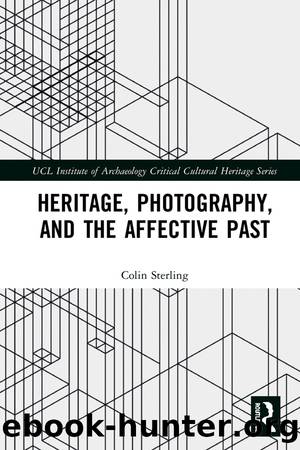Heritage, Photography, and the Affective Past by Colin Sterling

Author:Colin Sterling [Sterling, Colin]
Language: eng
Format: epub
Tags: History, Europe, General, Photography, Subjects & Themes, Historical, Landscapes
ISBN: 9780429648748
Google: FIirDwAAQBAJ
Publisher: Routledge
Published: 2019-08-28T15:57:13+00:00
This realisation led Izu to establish a childrenâs hospital in Siem Reap, just a short distance from the Angkor Archaeological Park. Since the mid 1990s any money that the photographer has earned from prints and publications related to Angkor have been invested in this project. Such a direct and ethically oriented engagement relies on the very affective force of the photograph as produced by Izu. The artistry and potentially unethical content of the image must thus be seen as just one node in the larger ethical dynamics of the photography complex, a network of actants that includes the photographed subject (the monuments themselves), the technological methods of production, the sale of prints and publications, and even the children who benefit from Izuâs charitable work. While photography is by no means the only route that such philanthropic ventures might take, the emergence of a certain photographic culture at sites such as Angkor does seem to have provoked a critical reflection on what the medium can and should do for disenfranchised constituents, particularly those who are routinely made the subject of photography or â and this is crucial â whose heritage is placed in a similar position. Representations that have sought to evoke the âtimelessâ and the âenchantedâ might in this respect be understood as both timely and resolutely pragmatic.
By foregrounding the wider ethical work to which photography might be aligned we are also made to consider the direct impact of the camera on a site. This line of inquiry will be pursued in some detail in later chapters (having already emerged in our discussion of Thomson), but as a way of summa-rising the arguments put forward here let us briefly return to McDermott, who has been described as the âAnsel Adams of Angkorâ (Gross 2007). This allusion, hastily rebuffed during my own conversation with the photographer, refers to the iconic status that McDermottâs images have attained. Like Adams at Yosemite Valley (see Liebovitz 2011), McDermott is thought to have âshaped the publicâs imaginationâ of a particular locality (Gross 2007). Such a conceptualisation neatly encapsulates the wider constructive and affective powers of photography that I examine in this book. In turn however this forces us to consider the ethics of âshapingâ heritage, whatever form this process of assembly and exploitation might take. As Miura makes clear, Angkor has a symbolic and inspirational importance for Cambodia as a whole, but it also remains âclosely linked to the everyday life of local villagers, together with their memories and ancestorsâ practicesâ (2011b: 113). By shaping â through fine-art photography â the imagination of those who might engage with the site in whatever capacity, McDermott (and others) risk diluting these alternative, vernacular ontologies.
The listing of Angkor as a World Heritage Site in the early 1990s should not be seen as a particularly radical juncture in terms of conservation practice, interpretation, or archaeological investigation at the site. For good reason, âSave Angkorâ was taken up by external and internal stakeholders alike as a rallying point for the revitalisation of Cambodia after decades of conflict and division.
Download
This site does not store any files on its server. We only index and link to content provided by other sites. Please contact the content providers to delete copyright contents if any and email us, we'll remove relevant links or contents immediately.
Spell It Out by David Crystal(36040)
Underground: A Human History of the Worlds Beneath Our Feet by Will Hunt(12022)
A Year in the Merde by Stephen Clarke(5323)
Venice by Jan Morris(2524)
Claridge's: The Cookbook by Nail Martyn & Erickson Meredith(2359)
My Paris Kitchen: Recipes and Stories by Lebovitz David(2255)
A TIME OF GIFTS by Patrick Leigh Fermor(2155)
The Plantagenets by Dan Jones(2039)
Welcome to the Goddamn Ice Cube by Blair Braverman(1990)
The Finnish Way by Katja Pantzar(1933)
Top 10 Prague (EYEWITNESS TOP 10 TRAVEL GUIDES) by DK(1930)
From Russia with Lunch by David Smiedt(1927)
Bang Poland: How To Make Love With Polish Girls In Poland by Roosh V(1921)
The Isle of Mull by Terry Marsh(1894)
A TIME TO KEEP SILENCE by Patrick Leigh Fermor(1863)
Rick Steves London 2018 by Rick Steves & Gene Openshaw(1822)
Insight Guides Experience Tokyo by Insight Guides(1814)
A Taste of Paris by David Downie(1811)
Merde in Europe by Stephen Clarke(1726)
